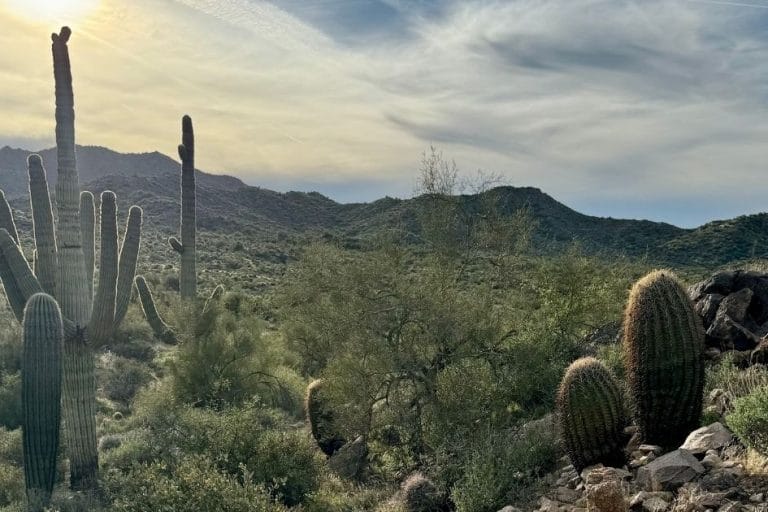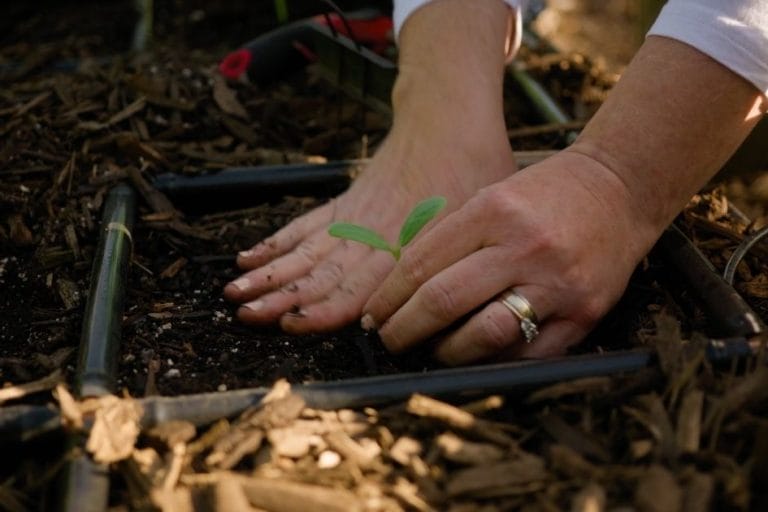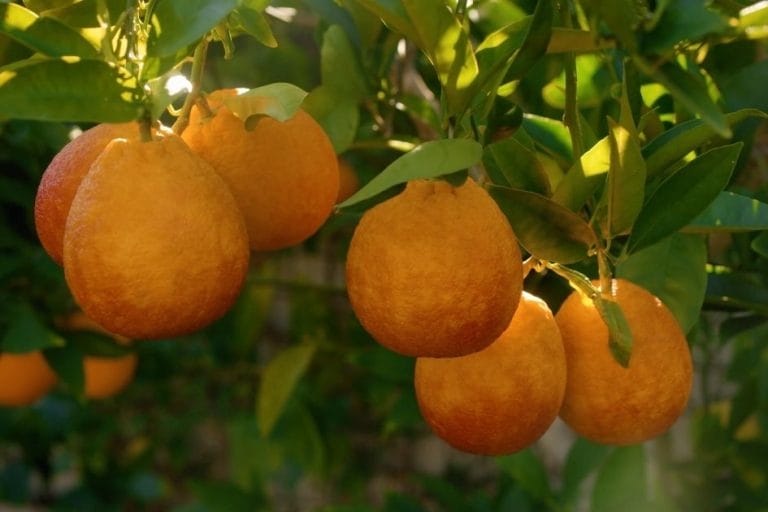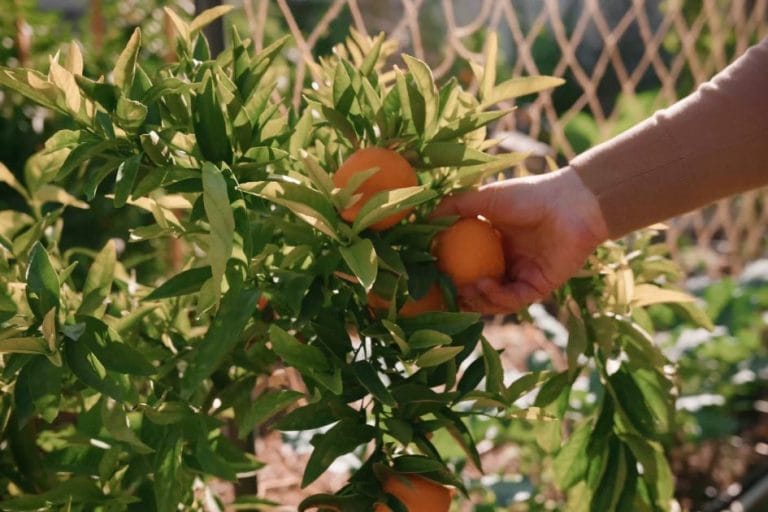October Desert Gardening

At the end of the summer, we are ready for the cooler mornings and pleasant (albeit a little warm) days of October. October is a busy month for the Arizona garden. Fortunately, the cooler temperatures are a welcome relief, and it’s a pleasure to be outside after the heat of the summer.
In this article, you’ll find the essential tasks to help your October vegetable, landscape, flower, and fruit garden be successful. We’ll also discuss common pests to watch out for and give guidelines for watering during this pivotal month.
October is ideal for planting many vegetables, herbs, and annual flowers. For specific details on what to plant and harvest in Arizona’s low desert during October, check out my planting guides or the blog post, “October’s Planting Guide for Arizona’s Low Desert.” The low desert includes areas below 3,500 feet in elevation, such as the Phoenix and Tucson metro regions.

“I’m so glad I live in a world where there are Octobers.”
— L.M. Montgomery
Click on the title to jump to that section and learn more about what to do during October:
- Vegetable Gardening
- My October Garden Journals
- Pests & Wildlife to Watch Out For This Month
- Container Gardening Tasks
- Flower Gardening Tasks
- Caring for Roses During October
- Herb Gardening
- Fruit Trees and Citrus
- Landscape Plants
- October Watering Guidelines
More October YouTube Videos
Vegetable Gardening
Last Chance to Prepare Beds For Fall Planting
Throughout the season, organic matter decomposes, and the soil level in your raised beds will naturally drop and need replenishing. Pull back the mulch and top the soil with worm castings and a fresh layer of compost. Add raised bed mix to bring the soil level back up if needed.
As temperatures cool, worms will come back into your in-bed vermicomposting bins. Once nighttime temperatures are consistently below 80°F (26°C), it’s time to refresh or start new bins. Learn how in this blog post.

Sunlight Considerations in October
Make sure your planting areas receive enough sunlight. With the sun lower in the sky during fall, spots that were in full sun during summer may now get much less light due to longer shadows. Choose locations that provide adequate sunlight for your new crops.
Once daytime temperatures are consistently below 90℉ (32°C), remove shade cloth (if using).
Transitioning From Warm to Cool-Season Crops
Transitioning your Arizona garden from warm-season to cool-season crops in October is all about making timely decisions. To know when it’s time to pull a plant and replace it, consider these questions:
- Is the plant healthy and free of pests or disease?
- Is it still producing well, or has its yield started to decline?
- Are you getting tired of eating the same produce?
- Do you want to use that space for something else?
As warm-season crops finish, get cool-season varieties planted. Planting cool-season crops while it’s still warm allows their roots to grow and develop quickly before temperatures cool in November and December.
In Arizona’s mild climate, certain warm-season crops like tomatoes, eggplants, peppers, and tomatillos can be treated more like perennials, growing and producing throughout fall and winter.
However, other warm-season crops, such as melons, beans, and cucumbers, are more sensitive to temperature changes and will decline once nighttime temperatures dip below 50°F. As these plants finish up, it’s time to replace them with cool-season crops.
If you would like to learn more about the principles of successful desert gardening, my guide, “Desert Gardening: How to Grow Vegetables in a Hot, Dry Climate,” may be helpful.

Other Vegetable Garden Tasks
- Cover newly planted seeds and seedlings with tulle to keep the birds from digging up seeds or eating seedlings.
- Add disease and pest-free garden trimmings and plants to your compost. Turn and spray down your compost. Learn more about composting here.
- Monitor roselle, sweet potatoes, and pomegranates for harvest readiness. Harvests of all three are possible in October.
- Thin newly planted seeds and seedlings so they have room to grow. This allows them to not compete for limited sunlight as the days get shorter.
- Artichokes come out of dormancy in the fall. Feed emerging artichokes with compost and worm castings to get them off to a good start.

My October Garden Journals

Twice a month, I send my personal garden journal to members of “Growing in the Garden Academy.” From the first seedling to the last harvest, you can follow my gardening adventures in Arizona’s unique low desert. Access the past three years of garden journals and monthly classes as a member.
Low Desert Arizona in October: Pests & Wildlife to Watch Out For This Month
Unfortunately, the cooler temperatures of October are inviting for pests.
- Monitor brassicas for cabbage worms. Handpicking is usually the best option. If you decide to treat, use BT. Spray only on affected plants and use a light hand. Learn how to get rid of cabbage worms in this guide.
- To keep whitefly infestations down, apply a soapy water solution of 1 Tablespoon Dawn (or other dish soap) to one gallon of water to the undersides of leaves daily.
- If rollie-pollies are eating seedlings, sprinkle a small amount of this slug and snail bait when you plant. Learn more in this blog post.
- Grasshoppers and crickets are common this month. Handpick. Hopefully, the birds help you out, too. If damage is severe, use Diatomaceous Earth. Follow package directions and reapply after rain.

Container Gardening Tasks
With cooler temperatures arriving, it’s time to bring out smaller containers. They are perfect for growing in during cooler months. Fill them with fresh Growing in the Garden Raised Bed Mix from Arizona Worm Farm or another high-quality potting mix. For larger containers, consider adding an olla to improve watering efficiency.
It’s generally best to start with fresh soil in containers. You can repurpose spent container soil by adding it to garden beds, using it as mulch for trees, or incorporating it into your compost. However, it’s also possible to replenish and rejuvenate the soil in your containers—this blog post explains how.
To refresh large containers, remove the mulch and any large roots. Moisten the soil and check for proper drainage. Then, fill the remaining space with new raised bed mix and add a balanced organic fertilizer.

Arizona October Garden Tasks: Flower Gardening
Once daytime temperatures consistently fall below 100℉ (38°C) and nights cool down below 80°F (27°C), remove warm-season flowers and plant your favorite cool-loving annuals this month. It’s crucial to plant cool-season annuals early in the season so their roots can get established in the warm soil. Water newly planted annuals each day until they show new growth and are established.
October in Arizona is the perfect time to plant wildflowers. See this guide to learn how.
Nasturtiums begin to pop up all around my garden in October. Nasturtiums are a great companion plant and a way to prevent garden pests organically. Consider planting some around your garden this month. Read this article to learn how to grow nasturtiums.

Caring for Roses During October in Arizona
Fertilize roses this month. Water well before and after fertilizing. Once nighttime temperatures are in the 70s (21-26°C), prune roses lightly to remove dead or diseased canes.
Plant roses this month. Choosing the right varieties helps ensure your roses survive the summer heat. Roses such as Memorial Day, Iceberg, and Julia Child are excellent choices as they are known for their resilience and ability to withstand high temperatures.
Are you thinking about adding more roses to your garden? I get all of my roses from Heirloom Roses. I love that they are own-root roses (no grafts!) and have the highest standards for diseases. You know you are getting robust, disease-free roses with strong roots when you get them from Heirloom Roses. Use Code GARDENAZ20 for 20% off any rose order through December 31, 2025.

Fruit and Fruit Trees
Consider where you will plant bare root fruit trees in January, and amend that soil now by burying food scraps, adding compost, or incorporating worm castings—anything to make the soil microbially active.
Peach trees and other deciduous fruit trees‘ leaves are beginning to change color in preparation for losing their leaves. Clean up around trees and remove any fallen fruit to prevent pests from overwintering near your trees. Consider planting garlic in your tree wells to deter pests as well. Read this article for more information about how to grow peach trees.
Many types of citrus begin to ripen in October. Skin color is not always an indicator of ripeness, so taste the fruit to see when it is ready. Fruit stores best on the tree. The longer the fruit stays on the tree, the sweeter the fruit becomes. Fruit will not ripen once picked. Ripe citrus fruit can be left on the tree for up to 6 months, depending on the variety.
Herb Gardening
Harvest basil regularly to ensure a continuous supply. If you want to save seeds, hold off on harvesting and allow basil to flower this month and form seeds. This article shares how to grow basil.
Bay leaf is putting on new growth. Harvest the largest, oldest leaves for the best flavor. See the growing guide here.
If your perennial herbs didn’t survive the summer, October is a great month to plant all perennial herbs. Learn more in this guide.

Landscape Tasks in October
October is the perfect time to enhance your Arizona landscape. Cooler temperatures make it less stressful for plants, allowing you to make significant changes for a thriving garden. Here’s what you can do this month:
Install or Replace Sprinkler Systems
Adding or replacing a sprinkler system now is ideal because it’s the least stressful time to disturb plant roots as they head into the cooler season.
Plant Landscape Plants
October is the best month to plant new landscape plants, giving them over six months to develop strong root systems before the heat returns. Roots can be established while the soil is still warm and daytime temperatures are moderate.
- Enhance Shade: Consider where you want to add shade and select low-water use, desert-adapted, flowering perennials to fill those areas.
- The updated Landscape Plants for the Arizona Desert booklet is now available. Find it online or at your local nursery for the latest tips and recommendations.

Tips for Buying and Planting Landscape Plants
Right Plant, Right Place:
- Observe Sunlight Patterns: Ensure the plants you choose can tolerate the sunlight conditions of their intended location.
- Check Mature Size: Refer to the plant tag or guide to understand how large the plant will grow. Avoid overcrowding by allowing space for plants to reach their full size.
- Opt for Young Plants: Buying younger plants allows them to adapt better to your landscape and grow naturally in their space.
Planting Tips:
- Prepare the Planting Hole: Dig a hole 3-4 times as wide as the root ball but not deeper. Fill it with water and ensure it drains out within a few hours. If the water doesn’t drain, that’s not a good place to plant.
- Positioning: Ensure the root ball is slightly above soil level and not buried too deep.
- Use Native Soil: Backfill with the original soil to encourage roots to spread outward. Avoid adding rich soil or compost to the hole.

Arizona Garden in October Watering Guidelines
Watering Containers During October
I usually water my containers every 3-5 days in October and fill up the ollas each time I water. I use ollas from Growoya.
Watering Annuals and Garden Beds During October
As nighttime temperatures decline, the time between watering gradually lengthens. Water to a depth of about 8-12 inches every 3-5 days, allowing the top of the soil to dry out before watering again. I usually water my raised beds every 3-5 days in September. I use the garden grids from Garden in Minutes to water them. (Use code Angela10 to save $10 off $100 or GITG5 to save 5 percent on any size order.)
Tree and Vine Watering Guidelines:
When daytime temperatures are below 100℉ (37°C), adjust the time between watering citrus and other fruit trees to around twice a month. Do this gradually by adding 1-2 days onto the watering frequency until your trees are watered twice a month.
- Established citrus trees should be watered once every 7-14 days to a 2-3 feet depth.
- Water annual fruit and high water use vines every 37-5 days to a depth of 8-12″.
- Water established fruit trees every 7-10 days to a depth of 18-24″.
- Grape vines need deep watering every 5 days.
- Water annual fruit and high water use vines every 2-5 days to a depth of 8-12″.
- Desert-adapted trees, shrubs & vines every 7-21 days (water to a depth of 24-36″ trees / 18-24″ shrubs / 8-12″ vines).
- High water use trees every 7-10 days (water to a depth of 18-24″).
- High water use shrubs every 5-7 days (water to a depth of 8-12″).
Source:
For additional information on watering practices, visit: “Association of Municipal Water Users Authority. (2023). Landscaping with Style in the Arizona Desert.” https://www.amwua.org/landscaping-with-style.







any chance you will have another garden class? if so I would love to sign up.
I will have another garden class in the spring. Be sure to sign up for my newsletter, I’ll announce it there first. Thanks.
Where can I get seed potatoes to plant this month? Your suggested retailers are sold out until next year to plant in the spring. Thank you I am learning so much from you!
Hi Monica, I’m glad the information has been helpful. I often start my own potatoes with organic potatoes from Sprouts and chit (pre-sprout) them before planting. If you have some smaller type potatoes that have begun to sprout on their own, use those, they will work too.
Hi Angela,
My family moved here to Mesa from California, and I’m so happy to have found your website and Youtube videos. I’m trying to plan ahead for fall planting and was wondering if your October “What to plant in the garden” flower planting guide is for planting seeds or transplants. I’ve looked at the ASU Cooperative Ext. planting calendar, and I couldn’t tell whether their planting guide is for seeds or transplants either, and that makes a big time difference…maybe I just missed something! Thanks 🙂
Good question. In my flower planting guide https://growinginthegarden.com/arizona-annual-flowers-visual-guide/ I list whether it grows best from seed or transplant. You can use that guide in connection with the October list. If you want transplants ready to plant you would need to start seeds indoors earlier for them to be ready.
Great, thanks 🙂
What do you like to use for fertilizer?
This is the one I like to use: https://growinginthegarden.com/best-organic-garden-fertilizer/ If you would rather buy it all ready to go I like this granular one:https://amzn.to/2G5bt0v or this liquid one: https://amzn.to/30pfzaF
everything I try to start from seed gets eaten, any tips on how to prevent this?
I have this happen to me in several of my beds as well. If birds are the issue, cover the seedlings/seeds with tulle or netting. If rollie-pollie type bugs are the issue that’s tougher. In my beds where that is a bad issue I do a few different things 1. plant larger seedlings 2. plant seeds that they don’t like 3. trap the bugs with yeast or citrus traps 4. Use newspaper collars or other barrier type methods. This article may help as well: https://growinginthegarden.com/organic-pest-control-that-really-works/
Hello Angela! My fiancé and I love all your tips and tricks for AZ gardening.
We are wondering when should we take our shade cloth down?
Thanks!
Natalie
I like to take it down once temps are below 90°F.
Hi Angela please help me I cant find l´itoi onion bulbs for sale nowhere
Native Seeds Search online often has them for sale.
Where can I purchase a blackberry plant?
Check local nurseries. I’ve seen them at Summerwinds and A&P.
Hello,
My wife and I are planning on buying FreezeDryer to help us store our foods for longer. However, I’ve seen several poor reviews regarding the HarvestRight system performancein a hot area like Arizona. Can you please tell me what special precautions we should take and what operating environment the system needs to perform optimally? Specifically I heard the vacuum pumps will not work well in the hot temps and errors out midway through a cycle and having to start from the beginning.
I plan on storing the FD in my garage. The temperature will be between 80-90 degrees. I can use a portable AC u it but it it will work without the extra electricity that would make me happy.
Thank you for your time. I hope to learn a lot about gardening and the freeze drying operation.
Cheers!
If you’re going to keep it in the garage it will be too hot during most of the year to operate it. If the room is any hotter than 78°-80°F the functionality suffers. I don’t use my freeze dryer much during the summer, but I use it quite often during the cooler months of the year.
Angela, I have a plant growing in my garden that I can’t identify: maybe you can, I will look for your email to send you a picture: it looks like lambs quarter but does not have the white dust- it has yellow lantern like flowers that grow on the underside of the plant.
Hi there, I was wondering if you could explain what the letters are next to the plant names (ST, S etc). Thank you so much!
SEED, TRANSPLANT, OR BOTH? S = Seed / T= Transplant / ST= Seed or Transplant